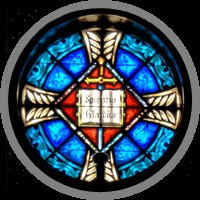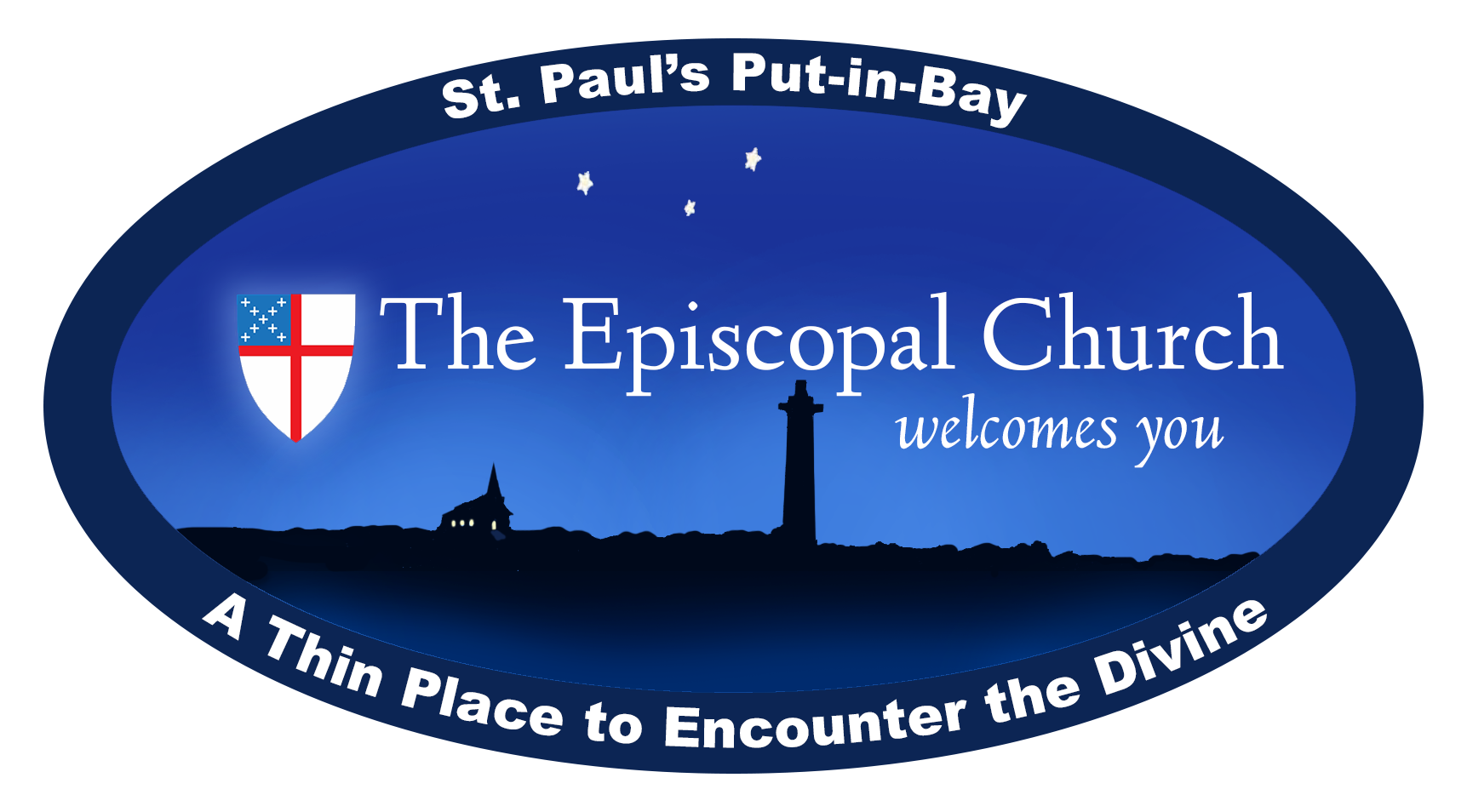St Paul’s is blessed to have a number of stained glass windows from the early 1900s. This selection represents the kinds of windows you will see when you visit the church.
The “Follow Me” Window (behind the altar) Matthew 4:19: In 1902 Mrs. Charles D. Barney (Laura L.), daughter of Jay Cooke, presented the altar window as a memorial to her mother with this inscription

To the Glory of God, and in loving memory of
Dorothea Elizabeth Allen Cooke, Born 1828 died 1871
‘He saith unto them: Follow Me”‘ St. Mat. 4-19.
Matthew 4:19 (MSG) 18-20 Walking along the beach of Lake Galilee, Jesus saw two brothers: Simon (later called Peter) and Andrew. They were fishing, throwing their nets into the lake. It was their regular work. Jesus said to them, “Come with me. I’ll make a new kind of fisherman out of you. I’ll show you how to catch men and women instead of perch and bass.” They didn’t ask questions, but simply dropped their nets and followed.
The grape vine, laden with purple grapes, and the fishermen with their net were selected based on their role as the products of the island, as well as the symbolic meaning from scripture. The window depicts the scene of Christ’s call to the fishermen, showing Him seated beneath a gnarled grape vine bearing fruit near the sea, earnestly conversing with Peter and Andrew, who with their net are sitting in front of Jesus with characteristically eager faces, displaying the impetuosity of the former and the sincerity of the latter as they yield to the Lord’s call in the spirit of worldly renunciation. The face of Christ is strikingly beautiful in its ardent earnestness and yearning desire for the partnership with those two fishermen.
The artist was Mrs Frances “Fanny” D Sweeny of Philadelphia who was an instructor of Stained Class and proprietor of her own business at the time this was created. Her works are frequently mistaken for Tiffany windows but her skill was developed before Tiffany was well known. She made windows for many other churches including the Lilly windows at Oak Lane United Church of Christ, Philadelphia. PA and a window titled an Angel in a field of lilies for First Presbyterian Church in Philadelphia installed there about 1898. She created a red rose stained glass window for “Tulpehocken Evangelical and Reformed Church near Myerstown, Pennsylvania, in Lebanon County. This church is now called Trinity UCC Richland, PA.
The Rev. Charles. H. Tucker, served as rector of St Paul’s when the Cooke window was placed in the church at a special worship service. (See the news article in the Port Clinton newspaper in October 1902 and Diocese of Ohio newspaper of fall 1902).
Cross and Crown: a traditional Christian symbol (a cross passing through a crown), appearing in many churches, that has also been used in heraldry. It is often interpreted as symbolizing the reward in heaven (the crown) coming after the trials in this life (the cross) (James 1:12).
The open Bible represents the Word of the Father. This Word is a faithful word, true and lasting. It not only instructs but also comforts and sustains. “The Word became flesh and dwelt among us, full of grace and truth,” John 1:14. This window was presented in memory of Dr. C.H.J. Linsky who was an active member of the church. He was the island physician and in 1878-1880 fhe was the first elected Mayor of Put-in-Bay.
The Chalice with Grapes: is the symbol for Holy Communion. The most popular symbol for the sacrament of Holy Communion is the chalice, reminding us of the cup which our Lord took and blessed at the Last Supper. The chalice symbolizes figuratively the bitterness of the suffering Christ at Gethsemane. The grapes symbolize the wine of Holy Communion which represents the blood of Christ. The vine leaves remind us of Jesus saying, “I am the vine, you are the branches” in John 15:5. The wheat is used to suggest the bounty of earth and as a representation of the bread which in communion symbolizes the broken body of Christ. This window was given in memory of Mathias Burggraf, who was a successful fruit raiser and wine maker, born June 2, 1825 in Baden, Germany. He came to the US in 1952 living in northern Ohio before settling his family on Put-in-Bay in July 1859. The window with the chalice and grapes was given in memory of Mathias Burggraf who died in 1920. He was a founding member of St. Paul’s, served as treasurer for many years and was active until his health prevented it.
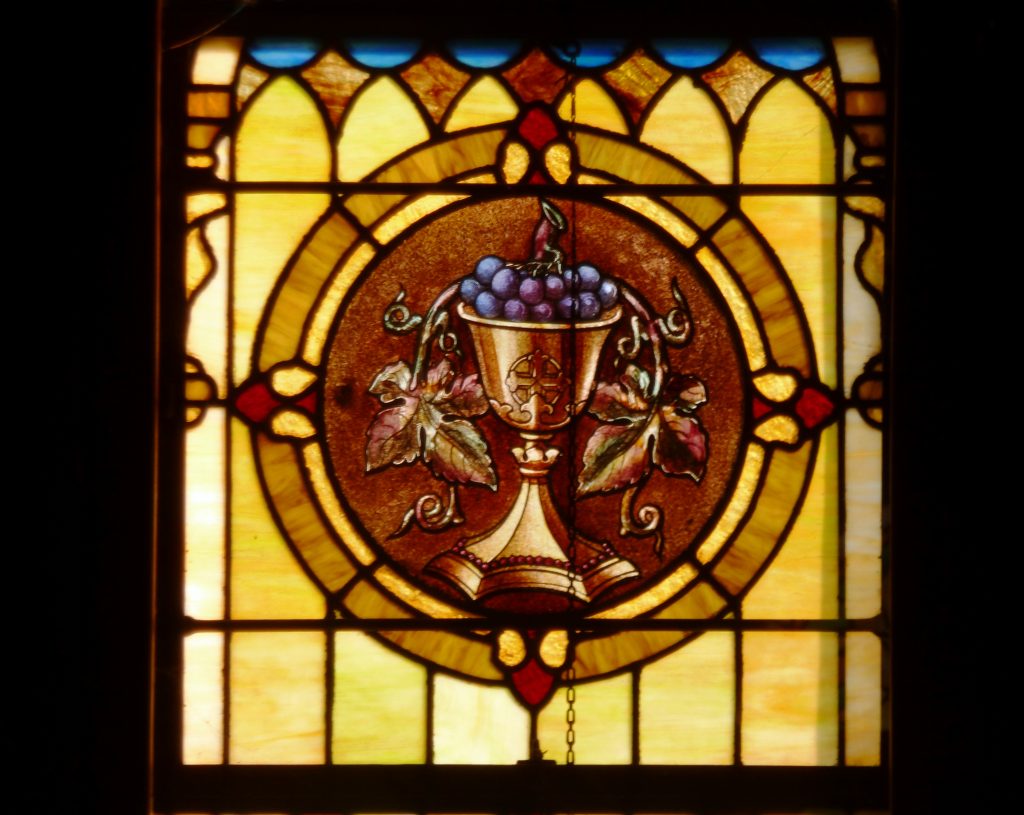
St John – The Eagle is the symbol of John the Evangelist. The eagle represents John because of his lofty and “soaring” gospel (it is much more theological in nature than the other three).
But those who hope in the Lord will renew their strength. They will soar on wings like eagles; they will run and not grow weary, they will walk and not be faint. (Isaiah 40:31)
Their faces looked like this: Each of the four had the face of a man, and on the right side each had the face of a lion, and on the left the face of an ox; each also had the face of an eagle. (Ezek. 1:10)
Faith, Hope, Charity: 1 Corinthians 13: The cross represents the central tenet of Christian belief. It symbolizes Jesus’ sacrifice and His obedience to the will of his Father. The empty cross also represents his resurrection. We are reminded by the cross that we are all sinners and in need of Christ’s redemption. The Bible is God’s inspired word given for our instruction and guidance. The open Bible on the next cushion reminds us that Christians are individually responsible for reading and interpreting the scriptures. The Chi-Rho representing the first letters of the words, “Jesus Christ” in Greek, was chosen for this cushion because it is the cross that represents words, thus making it an appropriate companion for the Word of God, our Bible.
Taken together, the cross and the Holy Bible portray Christ’s victory over sin, death, and the power of evil.
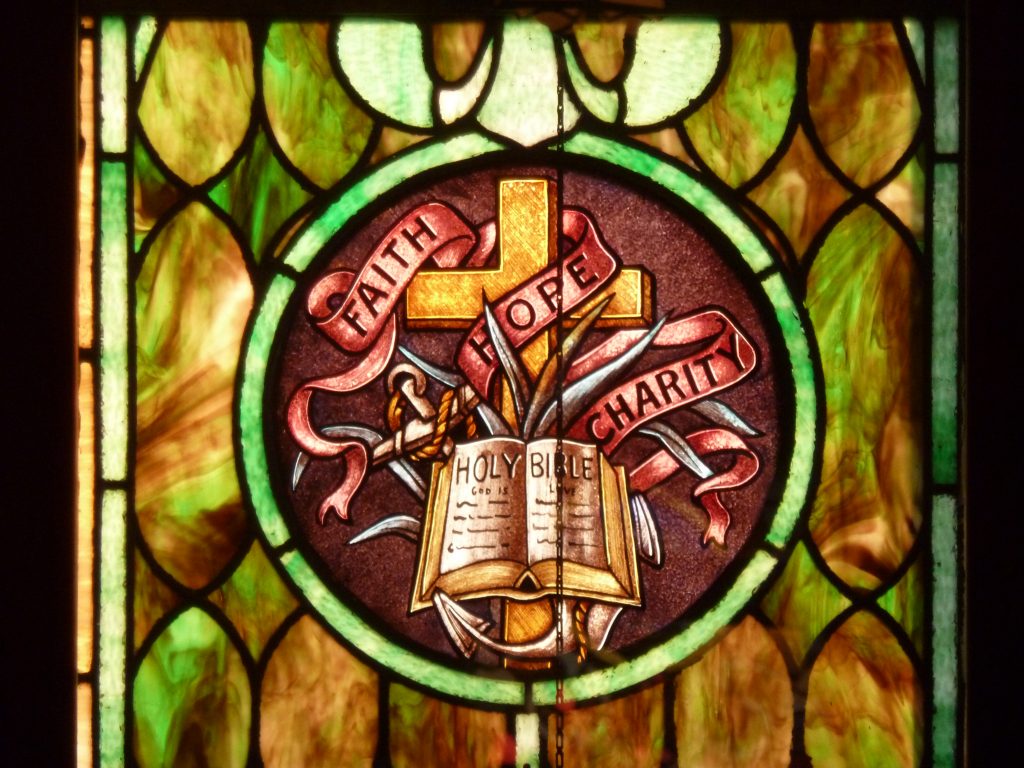
“For now we see through a glass, darkly; but then face to face: now I know in part; but then shall I know even as also I am known. And now abideth faith, hope, charity, these three; but the greatest of these is charity.”
Lamb of God: The Lamb symbolizes Jesus. The Cruciform Halo or Tri-Radiant Nimbus, signifies divinity – Jesus is God.He carries the Resurrection Banner of Victory as His work of redemption is a complete and Satan has been defeated. He stands upon the Book of Life. Three Seals evoke the Trinity and refer to Revelation 5 which declares that only The Lamb is worthy to open the seals and judge the world. Because the Book is closed it shows the final judgment has not yet taken place. There is still time to hear the Gospel and believe in Jesus Christ, the Lamb, who is our victorious Savior and Judge.
Holy Spirit: The dove is used many times in the Bible: as the spirit of salvation (Noah) and baptism (Jesus) Matthew 3:16. The human spirit is lifted up by God’s Spirit.
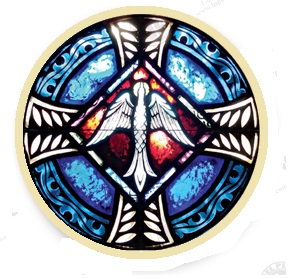
St Paul, Book & Sword – The symbol for the Apostle Paul is a sword behind an open Bible. The words are Latin: Spiritus “of the Spirit”, Gladius “the sword”. The open Bible is the Word, especially the saving Gospel of Christ. The sword is the power of the Spirit given to us, through the Word of God. Drawn from Ephesians 6:11-17, our Triune God instructs His children: “Put on the whole armor of God …take the sword of the Spirit which is the Word of God. This symbol is also known as “the Apostolic Shield of St. Paul”.
